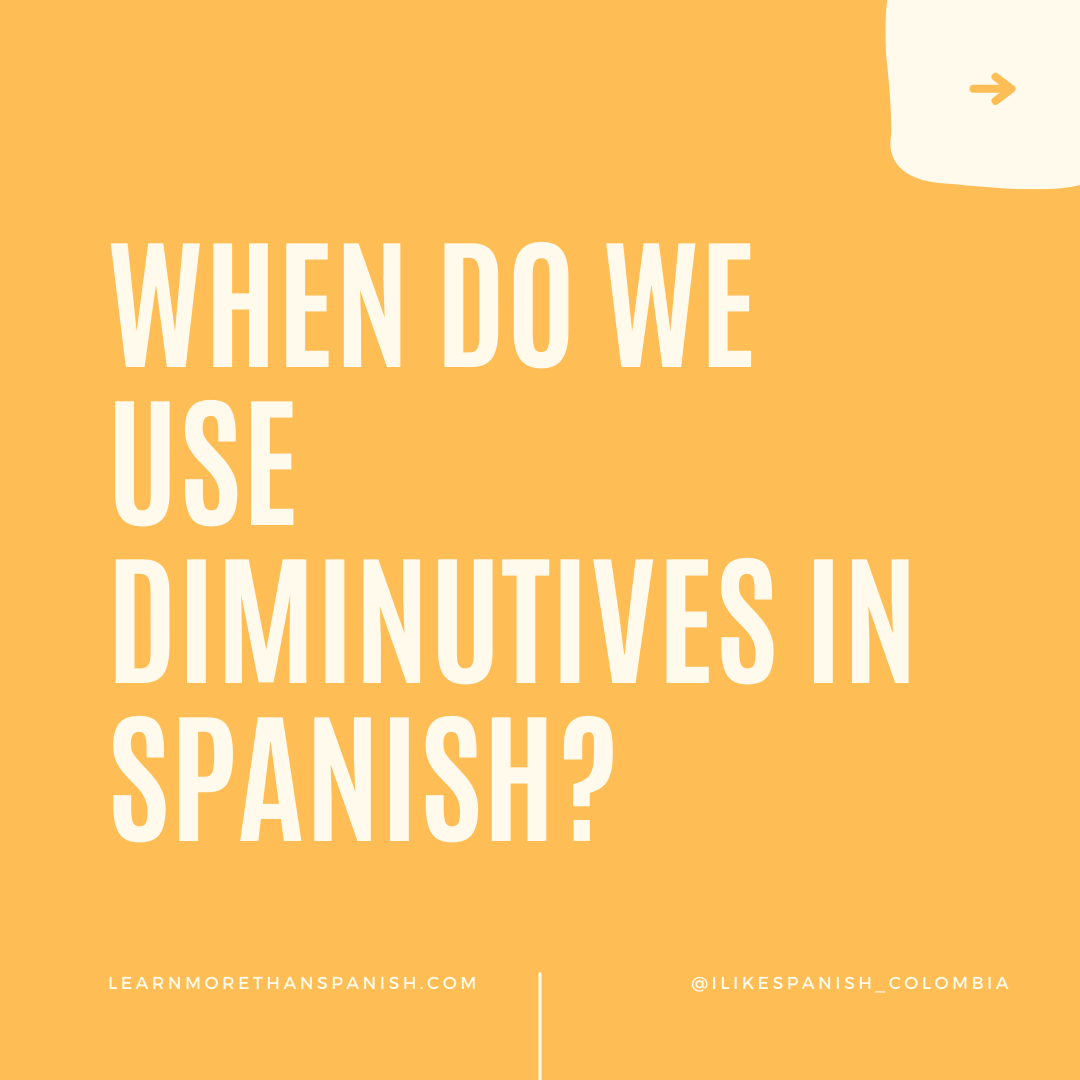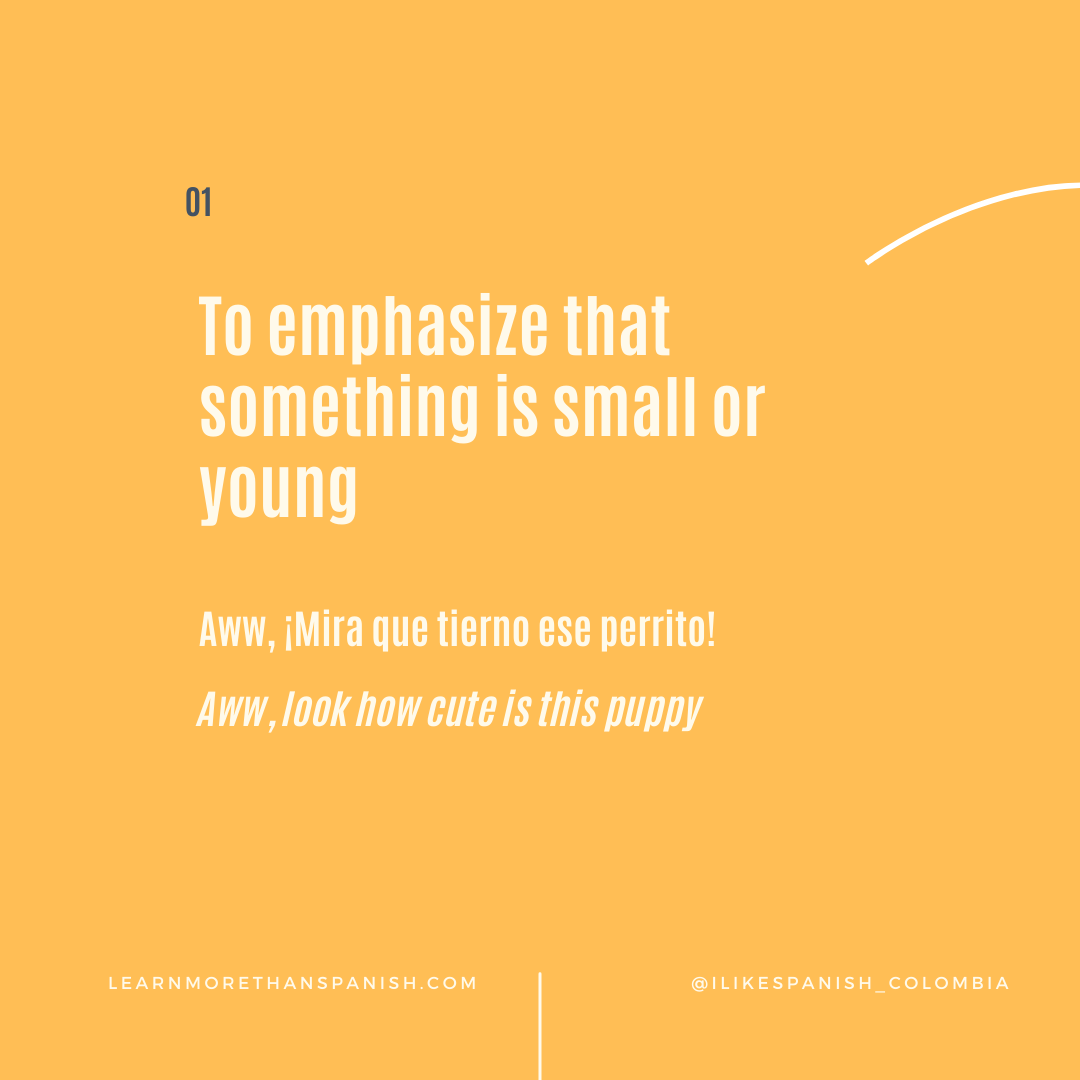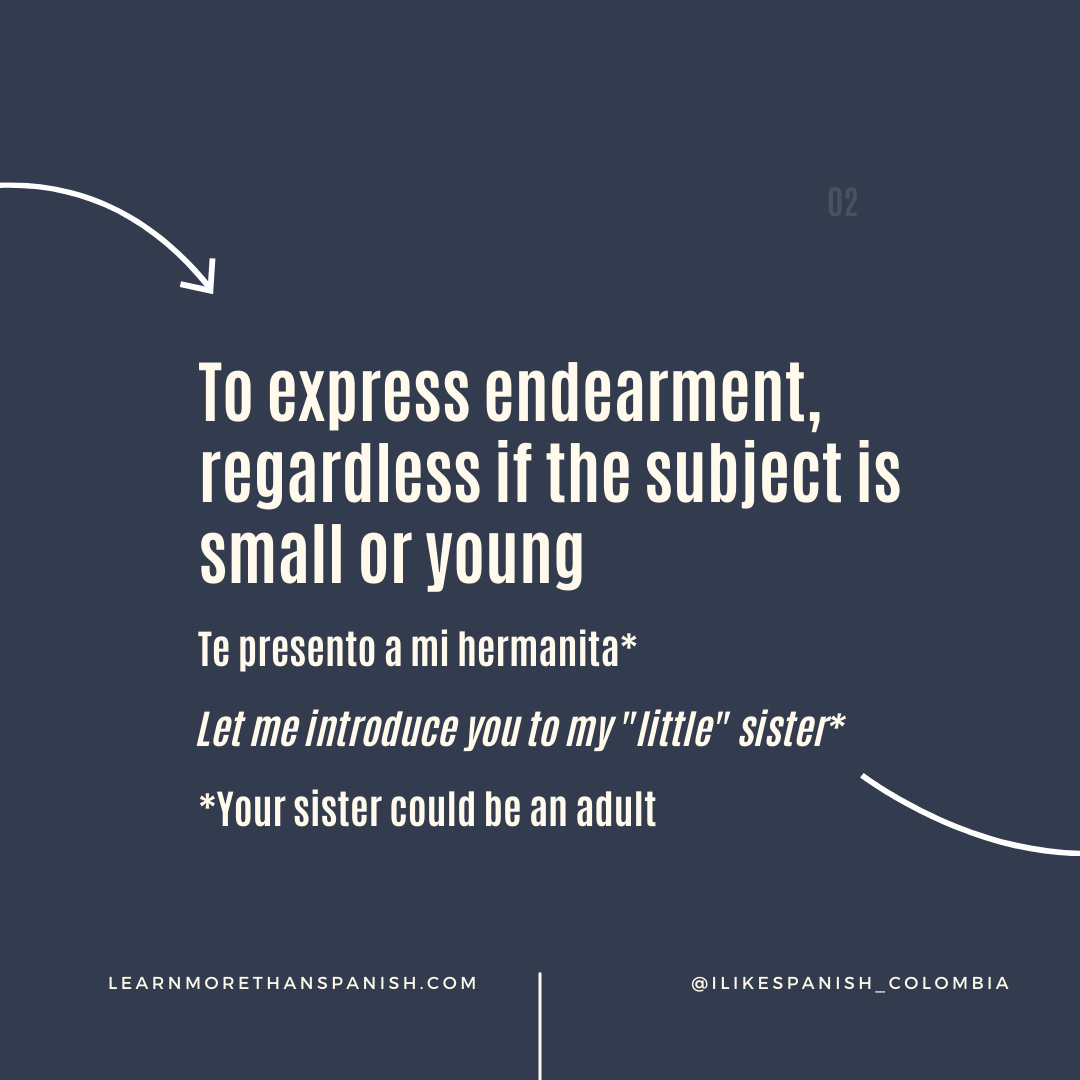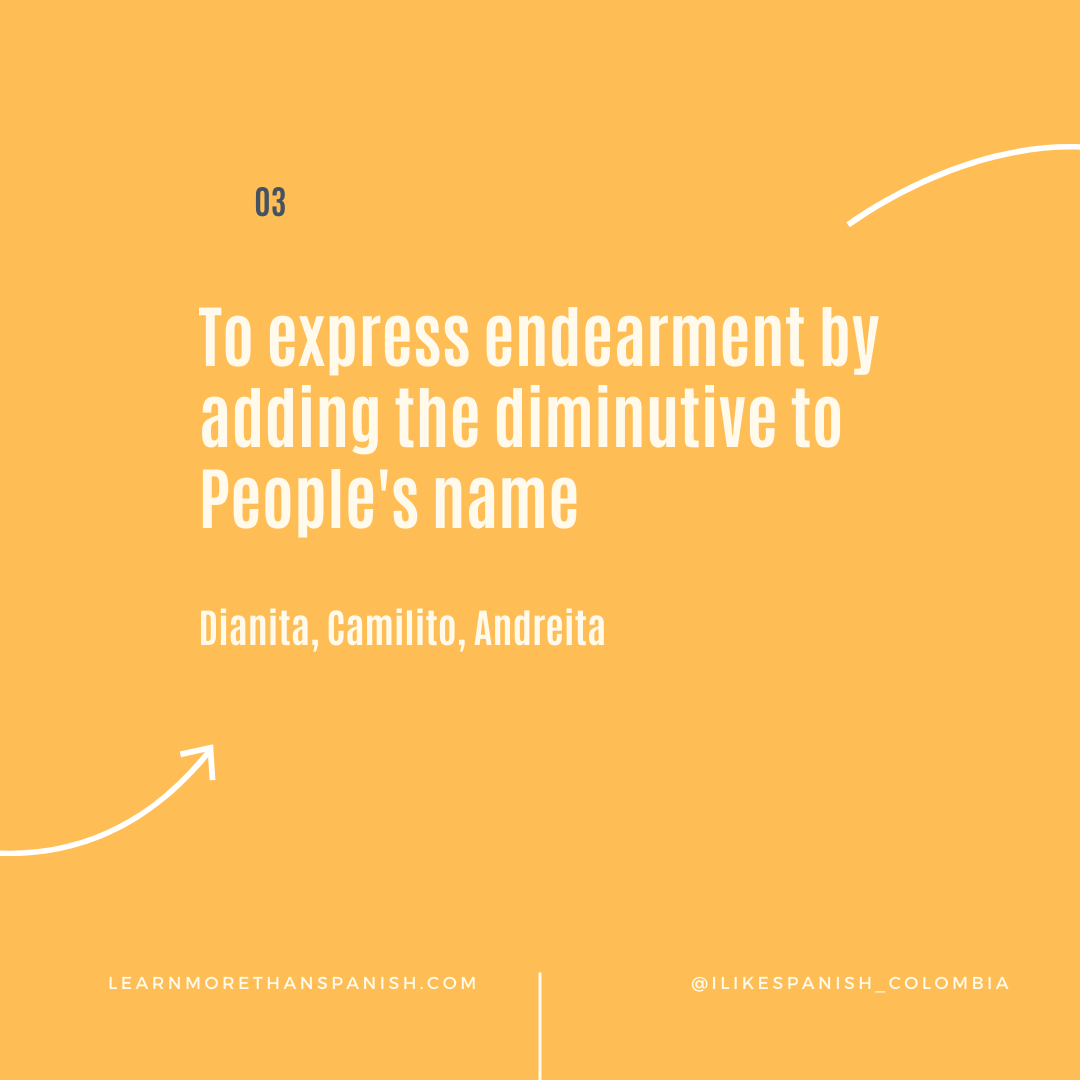Quick Guide to Master Diminutives in Spanish
Learning Spanish vocabulary is one thing, but understanding how native Spanish speakers speak is another.
Colombians, for example, use a lot of diminutives.
It is common to use diminutives during informal conversations among friends, but they can also be used during formal conversations, depending on the context.
Some people might say we overuse them, but diminutives are a way of expression for us.
In Colombia, we say:
Minutico…. instead of minuto
En cinco minuticos llego… (I’ll be there in 5 minutes)Cafecito (or tintico)… instead of café (or tinto)
¿Vamos por un cafecito? (Shall we go for a coffee?)
¿Le puedo ofrecer un tintico? (Can I offer you a coffee?)Dianita, Carlitos, Andreita… instead of Diana, Carlos, Andrea
Hola Carlitos, ¿Cómo vas? (Hi Carlos, how is it going?
You are probably already familiar with diminutives… You might have heard:
Despacito song!
(Despacio -> Despacito)
Hablo un poquito de español
(Poco -> Poquito)
Ahorita te llamo…
(Ahora -> Ahorita)
At first, it might sound complicated, but it’s way easier than you think.
Read carefully and start practicing with your friends, they will love it!
What’s a diminutive in Spanish?
It is a word with an added suffix that slightly changes the word’s meaning.
The closest English equivalent might be adding a “y” to the ending of a word, or adding “little” in front of a word.
For example:
Doggy (perrito) Vs. Dog (perro)
Little car (carrito) Vs. Car (carro)
When do we use diminutives in Spanish?
Diminutives can be applied basically to everything; it’s up to the person’s way of talking. However, it would be best not to overuse them in the same sentence.
- 1. To emphasize that something is small or young.
Aww, !¡Mira que tierno ese perrito!
(Aww, look how cute is this puppy) - To express endearment, regardless if the subject is small or young
Te presento a mi hermanita*
(Let me introduce you to my “little” sister*)
*Your sister could be an adult - To express endearment by adding the diminutive to People’s name
Dianita, Camilito, Andreita - To give an extra dose of love and care to our common flattering way of talk (too cheesy)
Amorcito, cariñito, bebecito, cosita, bizcochito, muñequita - To speak in a not-so-direct way
¿Estás manejando como rapidito, no?
(You’re driving a little fast, aren’t you?) - To speak with sarcasm
¿Vas como rapidito, no?
When someone is driving very slow and you want to say it with sarcasm…
To which words do we add diminutives in Spanish?
1. Nouns
Cajita (little box) – Caja (box)
Casita (little house) – Casa (house)
2. Adjectives
Feito (not so handsome) – Feo (ugly)
Bajito (not so tall) – Bajo (short)
Calientico (not so cold) – Caliente (hot)
3. Adverbs
Despacito (slowish)- Despacio (slowly)
Prontito (soonish) – Pronto (soon)
Tempranito (earlish) – Temprano (early)
4. Personal names
Pablito – Pablo
Susana – Susanita
Pedro – Pedrito
Learn how to use diminutives in Spanish
Diminutives are formed by adding the following suffix to the word’s ending, depending on the gender and grammar rule explained below.
– ito (masculine)
– ita (feminine)
– cito (masculine)
– cita (feminine)
If you are still struggling with Spanish gender, check out our Tips for mastering Spanish gender!
There are, of course, some exceptions… there are always exceptions!
You can also find the suffix –ecito or –ecita, and you can find cases where you should make some changes. See examples at the end of this section.
When to add – ITO or – ITA
1. When the word ends with O, or A, drop the last vowel, and change it to –ito or –ita
Casa → Casita
Hermano → Hermanito
Libro → Librito
Cama → Camita
Ensalada → Ensaladita
Mesa → Mesita
2. When the word ends in consonant (except for N, R), add -ito or -ita
Pastel -> Pastelito
Reloj -> Relojito
Papel -> Papelito
Reloj -> Relojito
– CITO (masculine) and – CITA (Feminine)
1. When the word ends in E, add -cito or -cita to the end:
Café -> Cafecito
Fuente -> Fuentecita
Suave -> Suavecito
2. When the word ends in N or R, just add -cito or -cita to the end:
Amor -> Amorcito
Rincón -> Rinconcito
Camion -> Camioncito
– ECITO (masculine) and – ECITA (femenine)
1. For all the words that have one syllable (pronounced with one sound), their diminutives will be formed with -ecito or -ecita
Sol -> Solecito
Pie -> Piecito
flor -> Florecita
2. The same rule applies to words that end with two vowels together, such as io, ia, ie etc.
Patio Patiecito
Novio -> Noviecito
Novia -> Noviecita
Spelling Changes
1. Change C to QU
It is often transformed to ‘qu’ to keep the harder ‘c’ sound, as in:
Poco -> Poquito
Cerca -> Cerquita
Chica -> Chiquita
2. Change Z to C
When word ends with Z, change it to C, and then add -cito, -cita, ecito, or -ecita
Lápiz -> Lapicito
Cerveza -> Cervecita
Lombriz -> Lombricita
Nariz -> Naricita
Arroz -> Arrocito
Luz – > Lucecita
Pez – > Pececito
3. G to GU
When the word ends in -GA, -GO -GUA,, you must add the letter U after the G to smooth the transition and end with the correct pronunciation, and then add -ito or -ita to the ending
Amigo -> Amiguito
Amiga -> Amiguita
Mango -> Manguito
Jugo -> Juguito
Advice!
With time and some practice, speaking with diminutives will become more natural to you. Our best advice for beginners is: Don’t use too many diminutives in a sentence!
Now go and practice!
Watch movies, read books, and pay attention to how your friends speak. Start using diminutives slowly.
If you want to improve your Spanish and get to know more about Colombian culture join our in-person or online classes.
Don’t forget to follow our social media, and read our blog to learn more than Spanish!
We hope to see you soon!



















